In a second release today the German automaker is announcing that a choice of three new V6 engines plus an 8-speed tiptronic transmission are now available for the 2011 Audi Q7 on the company’s home market.
Two of these V6 units will use gasoline and have different power levels while the third is a V6 TDI. All three engines combine forced induction and direct fuel injection plus the 2011 AUdi Q7 now comes with a high-performance system that recovers energy during
braking as standard.
The first new engine is the 3.0-litre TFSI that produces 272 HP and 400 Nm of toruqe, thanks to which the 2011 Audi Q7 sprints from 0 to 100 Km/h in 7.9 seconds and returns 22 mpg (10.7-litres per 100 Km).
The second version 2011 Audi Q7 3.0 TFSI has the same fuel consumption figures while outputing 333 HP and 440 Nm of torque, and accelerating to 100 Km/h from a standstill takes 6.9 seconds.
Finally the 2011 Audi Q7 3.0 TDI boosts 240 HP and 550 Nm of torque, that are enough to accelerate the German SUV to 100 Km/h from a standstill in 7.9 seconds and hit a top speed of 215 Km/h. Fuel consumption figures for the turbo diesel V6 version indicate that there are 7.4-litres needed to cover 100 Km (31.8 mpg).
Audi press release :
The Q7 is the large Audi for the sporty
individualist – the high-performance SUV for sport, leisure, family and
business. Now Audi has made it even more powerful and efficient, with a
choice of three new V6 engines and an 8-speed tiptronic transmission.
Engines: a new range
Even
more power, even higher efficiency: Audi has revised the engine lineup
for the Q7. The two gasoline engines, both V6 units but with different
power outputs, are new, and so is the second-generation V6 TDI. A
mighty V8 diesel completes the range. All the engines for the Q7
combine two technologies: forced induction and direct fuel injection. A
high-performance recuperation system that recovers energy during
braking is also a standard item with all six- and eight-cylinder
engines.
The new 3.0 TFSI gasoline engine embodies Audi’s
downsizing strategy: replacing engine displacement with supercharging.
Within the 90-degree angle formed by its cylinder blocks there is an
engine-driven supercharger that compresses the intake air. Two
charge-air intercoolers prevent the air temperature from rising, so
that the engine draws in more oxygen for the combustion process.
Vigorous thrust and spontaneous throttle response make the 3.0 TFSI
engine, with its sonorous note, an ideal source of power for the large
high-performance SUV from Audi.
Two versions of the supercharged
V6 are available. The basic version develops 200 kW (272 hp) and has a
maximum torque of 400 Nm (295.02 lb-ft) over a broad engine-speed range
from 2,250 to 4,750 rpm. It accelerates the Q7 in 7.9 seconds from a
standing start to 100 km/h (62.14 mph) and gives it a top speed of 222
km/h (137.94 mph), or 225 km/h (139.81 mph) with adaptive air
suspension.
The more powerful version of the 3.0 TFSI delivers
245 kW (333 hp) and a torque of 440 Nm (324.53 lb-ft) between 2,900 and
5,300 rpm. 100 km/h (62.14 mph) are reached in 6.9 seconds, with
powerful forward progress continuing until 243 km/h (150.99 mph) are
reached; with adaptive air suspension the top speed is 245 km/h (152.24
mph). Both versions of the 3.0 TFSI are impressively efficient: in the
EU fuel consumption test cycle they are content with 10.7 liters per
100 kilometers (21.98 US mpg). Compared with the previous engines, the
3.6 FSI and the 4.2 FSI, fuel consumption has been reduced by 1.4 and
2.0 l/100 km – 12 and 16 percent respectively.
The
second-generation 3.0 TDI, a new development, has effectively nothing
in common with its predecessor – apart from plenty of power! It has a
rated output of 176 kW (240 hp) and a constant 550 Nm (405.66 lb-ft) of
torque all the way from 1,750 to 2,500 rpm. This V6 diesel accelerates
the Q7 from a standstill to a typical main-road speed of 100 km/h (62.1
mph) in 7.9 seconds and reaches its top speed at 215 km/h (133.59 mph)
or, with adaptive air suspension, 218 km/h (135.46 mph). Its fuel
consumption is impressively low, averaging 7.4 liters per 100 km (31.79
US mpg), which is equivalent to CO2 emissions of 195 grams per
kilometer (313.82 g/mile). This is an improvement of 1.7 l/100 km or 19
percent.
The latest 3.0 TDI engine weighs much less than before:
198 kilograms (436.52 lb), a reduction of 20 kg (44.09 lb). A new
chain-driven timing gear and a complex cylinder wall machining process
have reduced internal friction. The new turbocharger is exceptionally
responsive, making itself felt as rapid torque buildup. The common rail
injection system has also undergone further development: it has a
maximum operating pressure of 2,000 bar and can therefore inject fuel
in an extremely precise spray pattern.
The crankcase and cylinder
heads of the new 3.0 TDI have separate cooling water circuits connected
together by valves. During the warm-up phase and when loads are not
high, the coolant is not circulated in the engine block. This saves
energy and raises the oil more quickly to its regular operating
temperature. The new start-stop system switches off the engine when the
Q7 comes to a standstill.
Audi also offers its customers a second
version of the V6 TDI: the 3.0 TDI clean diesel. It already meets the
exhaust emission limits laid down in the Euro 6 standard, which does
not come into force until 2014, and the tough US regulations as well.
Sensors in the combustion chambers, a common-rail fuel injection system
with a delivery pressure of up to 2,000 bar and a high-performance
exhaust gas recirculation system keep untreated exhaust emissions to a
minimum. A DeNox catalytic converter in the exhaust system reduces the
remaining oxides of nitrogen by means of an additive. The 3.0 TDI clean
diesel also develops 176 kW (240 hp) and has an impressive 550 Nm
(405.66 lb-ft) of torque between 2,000 and 2,250 rpm. It takes the Q7
from a standstill up to 100 km/h (62.14 mph) in 8.1 seconds and gives
it a top speed of 215 km/h (133.59 mph), or 218 km/h (135.46 mph) with
adaptive air suspension. Its average fuel consumption is 8.4 liters per
100 km (28.00 US mpg).
The Q7 4.2 TDI has also had its fuel
consumption drastically reduced – from 9.9 (23.76 US mpg) to 9.2 liters
per 100 km (25.57 US mpg) – by installing a 2,000-bar fuel injection
system and minimizing internal friction. Yet at the same time the V8
diesel, with its unchanged power output of 250 kW (340 hp), delivers
more torque than before. It now supplies a vigorous 800 Nm (590.05
lb-ft) between engine speeds of 1,750 and 2,750 rpm. The big TDI engine
gives the Q7 performance figures worthy of a sports car. It accelerates
from 0 to 100 km/h (62.14 mph) in 6.4 seconds and has a top speed of
242 km/h (150.37 mph).
Power transmission: eight speeds are standard
Audi
has given all six- and eight-cylinder Q7 versions a new automatic
transmission. The eight-speed tiptronic lowers fuel consumption by
about five percent. It is based on the six-speed unit, but with another
friction-clutch shift element added. Being able to shift between eight
ratios keeps the jumps in engine speed low: the engine always runs
close to its ideal operating point. All gear shifts are fast, flexible
and take place extremely smoothly without delay.
At 7.25 to 1,
the overall spread of ratios in the eight-speed tiptronic is unusually
wide. In the lower ratios the Q7 accelerates powerfully; in the higher
ratios it rolls along efficiently at low engine speeds.
To cut
fuel consumption still further, the torque converter lockup clutch
eliminates slip even at low engine speeds. Any engine vibration that
could occur as a result is suppressed by the new damper in the torque
converter until scarcely any trace can be detected.
Drivers can
choose between the D and S programs – or make their own gear shifts at
the transmission selector lever or the optional steering-wheel paddles.
In combination with the 3.0 TDI the new eight-speed tiptronic achieves
an exceptionally high level of efficiency. Its oil cooler is heated
after a cold start by hot coolant from the engine’s cooling system. An
electric oil pump makes operation of the Q7’s start-stop system
possible: it maintains oil pressure in the hydraulic circuit when the
engine stops, and closes the clutch for restarting.
The
eight-speed tiptronic transmission transfers engine power to the
quattro permanent all-wheel drive train. This splits the power in a
sporty manner, with 40 percent going to the front and 60 percent to the
rear wheels, but in certain on- or off-road situations, the
mechanical-action center differential can direct up to 65 percent of
the power to the front or up to 85 percent to the rear.
The chassis: agile and safe
The
Q7 is one of those personalities who are at home wherever they may be.
On the road it excels with its precise, sporty handling, and where the
hardtop surface ends it demonstrates impressive offroad
characteristics. The suspension uses double wishbones made of aluminum,
attached to separate subframes. The wheel bearings have been optimized
to reduce friction. The servotronic steering varies the degree of power
assistance according to the vehicle’s speed.
The optional
adaptive air suspension (standard on the Q7 4.2 TDI and Q7 V12 TDI)
with electronic shock absorber control varies the ride height to suit
the actual situation. On a high-speed road it lowers the body for
enhanced stability and lower fuel consumption. Across rough terrain it
raises the body if a button is pressed. At the standard MMI terminal
the driver can choose between five operating modes: comfort, automatic,
dynamic, offroad and lift. The adaptive air suspension is also
available as a dynamic S line version.
The Audi Q7 has 18-inch
wheels with 235/60 or 255/55 tires, depending on the chosen engine. But
other wheels up to 21 inches in diameter can be selected as optional
extras. Braking is looked after by large ventilated disks. With the two
most powerful engines even larger disks made from lightweight
carbon-fiber reinforced ceramic material are available. They are
gripped firmly when the need arises by black callipers with “Audi
ceramic” lettering. The ESP stabilization program includes an off-road
mode as standard that gives priority to traction on a loose surface.
And when the driver encounters a steep downhill slope off-road, the
hill descent assist is a useful aid.
Design and body: sculpture in motion
The
design of the Q7 stands for power and presence; it is the visual
expression of this large SUV’s character. Flowing surfaces create a
moving sculpture, with the coupé-like roofline, the low window strip
and the tautly curved panel surfaces being distinctive visual features.
The outlines are sporty, strong and elegant.
The Audi Q7 is 5.09
meters (16.70 ft) long, 1.98 meters (6.50 ft) wide and 1.74 meters
(5.71 ft) high. Its wheelbase of 3 meters (9.84 ft) creates a luxurious
amount of space inside. The front-end styling is dominated by the large
singleframe grille with chromed surround, and the headlamps. As an
optional extra Audi can supply a xenon plus version with LED daytime
driving lights and LED flashers, and also an adaptive light version
with integrated turning and cornering lights as well as the low, full
and highway beams.
Standard LEDs in the rear lights create a
distinctive lighting pattern. The tailgate, which wraps around the rear
roof posts in an S-shaped outline, and also the hood and the front
fenders are made of aluminum. Audi supplies the add-on parts in a
contrasting color as standard, or, if desired, in the same color as the
body. The Audi Q7 always leaves the assembly line with a high-gloss
package. Optional extras are the black styling package or the
aluminum-look exterior package, which consists of an all-round chrome
trim strip on the bumpers, door capping strips and door handles, and
gives the Q7 even greater sophistication. The optionally available S
line exterior package also adds further visual emphasis to this SUV’s
sporty potential.
The interior: abundant space
The
Q7 sets standards for flexibility: no fewer than 27 seat configurations
are possible. Depending on the wishes of the customer, Audi can supply
its large SUV as a five-, six- or seven-seat version. This last version
has comfortable single rear seats and a third row of seats at the back
for occupants up to 1.60 meters (5.25 ft ) tall. As a standard feature,
the seat backs in the second row can be folded down to provide a level
cargo floor. This increases load capacity from 775 liters (27.37 cubic
ft) to 2,035 liters (71.87 cubic ft) in volume.
Operation of
the controls is simple and logical, and the clearly marked instruments
are easy to read. For the driver and front passenger there is a choice
of three seat versions: standard seats, electrically adjustable sport
seats and climatized luxury seats that can be both heated and
ventilated. The elegant lines of the interior, with many restrained
details, communicate the typical feeling of wellbeing that the Audi
driver or passenger enjoys. The ambient lighting provides subtle
highlights, and many of the control elements have fine chrome trim. The
workmanship is typical of Audi – quality with no compromises.
The
choice of colors and materials emphasizes the distinguished character
of the interior of the Q7. A variety of leather grades, headlinings and
inlays are available, and for the individualist there are leather and
design packages of various styles. The S line sports package uses cool
black throughout the interior, with subtle accents in the trim and
upholstery. Among the items it includes are sports suspension and
20-inch wheels.
Equipment and trim: the highest standards of luxury
The
Audi Q7 comes with an opulent array of standard equipment features,
including two-zone deluxe automatic air conditioning, high-beam
assistant, an MMI radio operating system complete with audio system and
eight speakers, a double load floor in the cargo area with storage
compartment and a dirt tray. Roof rails are also fitted.
A
standard item when the optional driver information system is chosen is
the on-board computer with efficiency program. This monitors the
vehicle’s energy flows and displays the requirements of the most
important consumers, with hints on how to reduce consumption.
The
list of optional extras includes such luxury features as the
convenience key, four-zone automatic air conditioning, a dark glass
panoramic roof and a cool box. Items of interest for sport and leisure
include an electric tailgate mechanism, baggage retaining rails and a
sliding storage box. In the program of accessories are such items as a
pivot-head tow hitch – the large SUV can tow a trailer weighing up to
3.5 metric tons (7,716 lb).
In the infotainment area Audi also
offers a complete modular system. The top-of-the-line version has an
integral hard disk drive for navigation, music, and telephone data, a
color monitor with 3D graphics, a DVD player, and voice control. It can
be expanded into a luxury media center with features such as a
Bluetooth telephone, TV tuner, digital radio tuner, plus rear seat
entertainment. A special highlight is the Advanced Sound System from
Bang & Olufsen with its 14 channels, 1,000 watts of power and 14
speakers. In the cockpit area two acoustic lenses reproduce the treble
frequencies; when the system is started, they extend out of the dash
panel.
The range of optional equipment is rounded off by advanced
driver assistance systems. The adaptive cruise control system regulates
speed and following distance by means of targeted accelerating and
decelerating. If a risk is detected, the integral Audi braking guard
provides a warning. Audi lane assist helps the driver to stay in lane;
Audi side assist employs radar to help drivers change lanes more
safely. The Audi parking system advanced assists parking by means of a
rearview camera.
The Audi Q7 V12 TDI quattro: the most powerful diesel SUV in the world
The
Audi Q7 V12 TDI quattro is the most powerful diesel SUV in the world.
Its 6-liter twelve-cylinder TDI engine develops 368 kW (500 hp) and
delivers 1,000 Nm (737.56 lb-ft) of torque between 1,750 and 3,250 rpm
to the six-speed tiptronic transmission. With a time of just 5.5
seconds from zero to 100 km/h (62.14 mph) and a governed top speed of
250 km/h (155.34 mph), the Audi Q7 V12 TDI quattro matches the
performance of a powerful sports car, but is content with a fuel
consumption of only 11.3 liters per 100 kilometers (20.82 US mpg).
The
luxurious standard equipment specification of the Audi Q7 V12 TDI
quattro includes 20-inch wheels, Audi ceramic brakes, xenon plus
headlights, adaptive air suspension, a Bose sound system, sport seats
and many other features. This top version also has a number of striking
body details that identify it immediately.
The equipment,
data and prices specified in this document refer to the model range
offered in Germany. Subject to change without notice; errors and
omissions excepted.
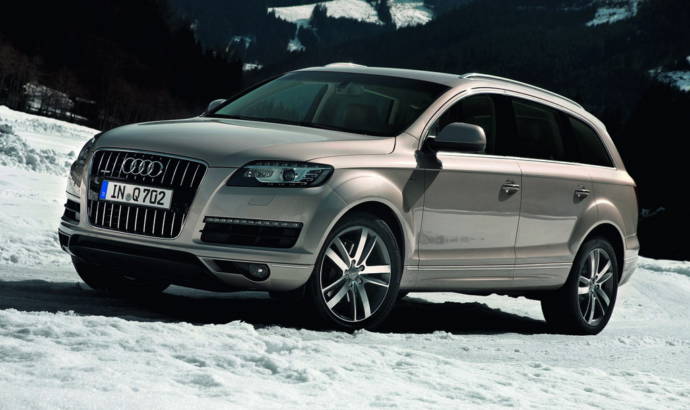
07 Apr 2010
1
2011 Audi Q7 3.0 TFSI and TDI
1 Comment
Comments are closed.

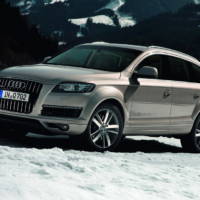
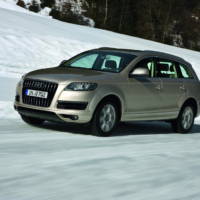
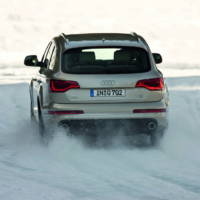
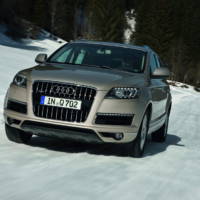
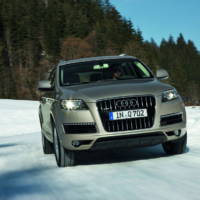
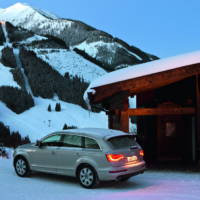
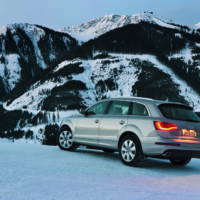
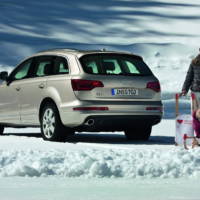
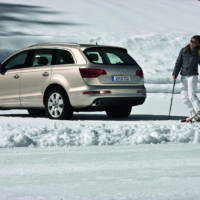
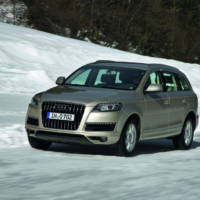
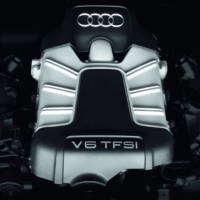
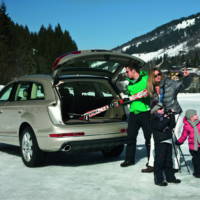
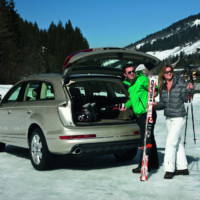
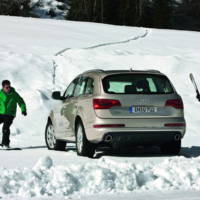
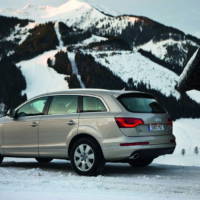
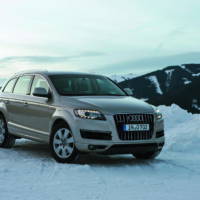
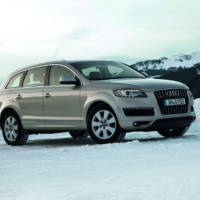
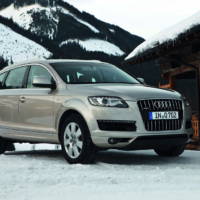
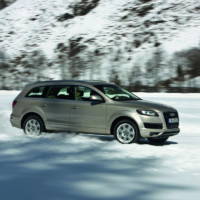
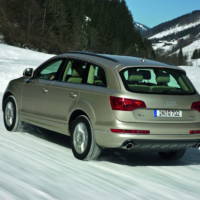
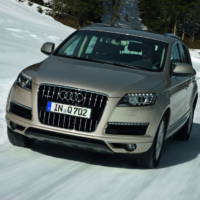
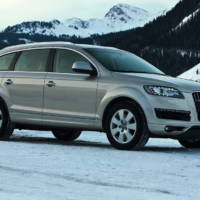
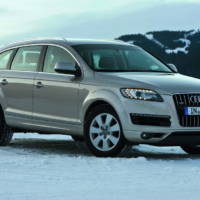
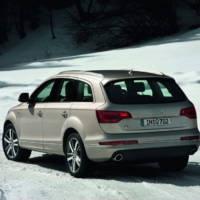
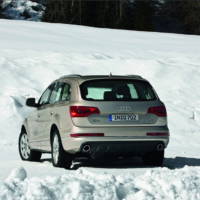
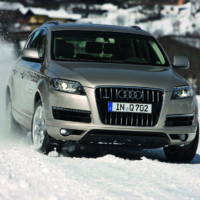
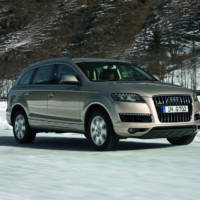
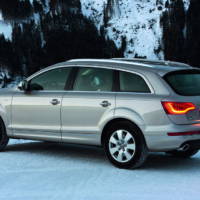
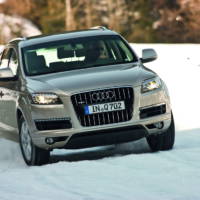
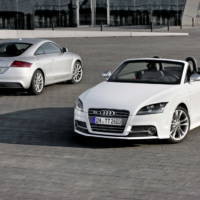
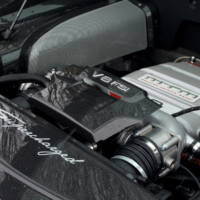
where is the deisel fuel and engine oil filter located in this model